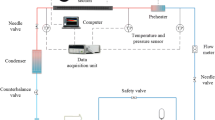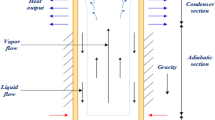Abstract
This study elucidates the hydrothermal characteristics of a capillary-driven stepped heat pipe (SHP). An axisymmetric numerical simulation is performed to analyze the effects of step pattern, area ratio (AR), evaporator length (LE), and wick parameters on the system characteristics. The results of the numerical model show good agreement with data from literature. These results suggest that superior performance can be achieved with a two-sided step and a step with sudden contraction with an enlarged evaporator. SHPs with a large area ratio (AR > 1) and a long evaporator yield superior thermal and capillary performances; those with a small condenser diameter (AR < 1) are more likely to experience dryout. Wick parameters, such as porosity (ε) and wick type, play a vital role in the system performance. Numerical results under the studied conditions can provide a clear engineering guide for the design of SHPs used in various engineering applications.
Similar content being viewed by others
Abbreviations
- A :
-
Area [m2]
- AR :
-
Area ratio
- c p :
-
Specific heat at constant pressure [J/kg-K]
- d :
-
Wire diameter [m]
- h lv :
-
Latent heat of water vapor [J/kg]
- k :
-
Thermal conductivity [W/m-K]
- K :
-
Permeability [m2]
- L :
-
Length [m]
- m :
-
Mass transfer [kg/s]
- M :
-
Mass of the phase [kg]
- N :
-
Number of mesh screens
- P :
-
Pressure [N/m2]
- q″:
-
Heat flux [W/m2]
- Q :
-
Heat load [W]
- r :
-
Radial direction
- R :
-
Radius [m]
- R g :
-
Specific gas constant [J/kg-K]
- R th :
-
Thermal resistance [K/W]
- S :
-
Step-size [m]
- t :
-
Time [s]
- T :
-
Temperature [K]
- U :
-
Velocity [m/s]
- ΔV :
-
Cell volume
- z :
-
Axial direction
- a :
-
Thermal diffusivity [m2/s]
- Δ :
-
Difference
- μ :
-
Dynamic viscosity [kg/m-s]
- ε :
-
Porosity
- ρ :
-
Density [kg/m3]
- σ :
-
Accommodation coefficient
- A :
-
Adiabatic
- B :
-
Baseline
- C :
-
Condenser
- eff :
-
Effective
- E :
-
Evaporator
- EC :
-
Ergun coefficient
- i :
-
Interface
- l :
-
Liquid phase
- O :
-
Reference
- OP :
-
Operating
- r :
-
Radial direction
- s :
-
Solid wick material
- v :
-
Vapor phase
- W :
-
Wall
- WC :
-
Wall condenser
- WE :
-
Wall evaporator
- z :
-
Axial direction
- 0 :
-
Old value
- *:
-
Previous iteration
References
B. Zohuri, Functionality, Advancements and Industrial Applications of Heat Pipes, Academic Press (2020).
D. Reay, R. McGlen and P. Kew, Heat Pipes: Theory, Design and Applications, Butterworth-Heinemann (2014).
J. Meseguer, I. Pérez-Grande and A. Sanz-Andrés, Spacecraft Thermal Control, Woodhead Publishing (2012).
A. Faghri and Y. Zhang, Transport Phenomena in Multiphase Systems, Elsevier (2006).
H. Jouhara, A. Chauhan, T. Nannou, S. Almahmoud, B. Delpech and L. C. Wrobel, Heat pipe based systems-advances and applications, Energy, 128 (2017) 729–754.
X. Chen, H. Ye, X. Fan, T. Ren and G. Zhang, A review of small heat pipes for electronics, Applied Thermal Engineering, 96 (2016) 1–17.
A. Faghri, Review and advances in heat pipe science and technology, Journal of Heat Transfer, 134 (2012) 123001.
C. W. Chan, E. Siqueiros, J. Ling-Chin, M. Royapoor and A. P. Roskilly, Heat utilisation technologies: a critical review of heat pipes, Renewable and Sustainable Energy Reviews, 50 (2015) 615–627.
K. Zeghari, H. Louahlia and S. Le Masson, Experimental investigation of flat porous heat pipe for cooling TV box electronic chips, Applied Thermal Engineering, 163 (2019) 114267.
W. Zhou, Y. Li, Z. Chen, L. Deng and Y. Gan, A novel ultra-thin flattened heat pipe with biporous spiral woven mesh wick for cooling electronic devices, Energy Conversion and Management, 180 (2019) 769–783.
S. Maalej, A. Zayoud, I. Abdelaziz, I. Saad and M. C. Zaghdoudi, Thermal performance of finned heat pipe system for central processing unit cooling, Energy Conversion and Management, 218 (2020) 112977.
M. A. Hayat, H. M. Ali, M. M. Janjua, W. Pao, C. Li and M. Alizadeh, Phase change material/heat pipe and copper foam-based heat sinks for thermal management of electronic systems, Journal of Energy Storage, 32 (2020) 101971.
H. Sun, S. Tang, C. Wang, J. Zhang, D. Zhang, W. Tian, S. Qiu and G. Su, Numerical simulation of a small high-temperature heat pipe cooled reactor with CFD methodology, Nuclear Engineering and Design, 370 (2020) 110907.
R. J. Xu, X. H. Zhang, R. X. Wang, S. H. Xu and H. S. Wang, Experimental investigation of a solar collector integrated with a pulsating heat pipe and a compound parabolic concentrator, Energy Conversion and Management, 148 (2017) 68–77.
A. Shafieian, M. Khiadani and A. Nosrati, Strategies to improve the thermal performance of heat pipe solar collectors in solar systems: a review, Energy Conversion and Management, 183 (2019) 307–331.
K. Grissa, A. M. Benselama, Z. Lataoui, C. Romestant, Y. Bertin and A. Jemni, Performance of a cylindrical wicked heat pipe used in solar collectors: numerical approach with Lattice Boltzmann method, Energy Conversion and Management, 150 (2017) 623–636.
W. Zhou, Y. Li, Z. Chen, L. Deng and Y. Gan, Effect of the passage area ratio of liquid to vapor on an ultra-thin flattened heat pipe, Applied Thermal Engineering, 162 (2019) 114215.
J. Zhang, L. X. Lian, Y. Liu and R. Q. Wang, The heat transfer capability prediction of heat pipes based on capillary rise test of wicks, International Journal of Heat and Mass Transfer, 164 (2021) 120536.
F. Xin, T. Ma and Q. Wang, Thermal performance analysis of flat heat pipe with graded mini-grooves wick, Applied Energy, 228 (2018) 2129–2139.
A. R. Anand, Analytical and experimental investigations on heat transport capability of axially grooved aluminium-methane heat pipe, International Journal of Thermal Sciences, 139 (2019) 269–281.
D. Somasundaram, A. Mani and M. Kamaraj, Experimental investigation of thermal performance of metal foam wicked flat heat pipe, Experimental Thermal and Fluid Science, 82 (2017) 482–492.
W. Zhou, Y. Li, Z. Chen, L. Deng and B. Li, Experimental study on the heat transfer performance of ultra-thin flattened heat pipe with hybrid spiral woven mesh wick structure, Applied Thermal Engineering, 170 (2020) 115009.
L. Jiang, Y. Huang, Y. Tang, Y. Li, W. Zhou, L. Jiang and J. Gao, Fabrication and thermal performance of porous crack composite wick flattened heat pipe, Applied Thermal Engineering, 66 (2014) 140–147.
L. Jiang, J. Ling, L. Jiang, Y. Tang, Y. Li, W. Zhou and J. Gao, Thermal performance of a novel porous crack composite wick heat pipe, Energy Conversion and Management, 81 (2014) 10–18.
A. B. Solomon, A. K. Mahto, R. C. Joy, A. A. Rajan, D. A. Jayprakash, A. Dixit and A. Sahay, Application of bio-wick in compact loop heat pipe, Applied Thermal Engineering, 169 (2020) 114927.
S. Sudhakar, J. A. Weibel, F. Zhou, E. M. Dede and S. V. Garimella, The role of vapor venting and liquid feeding on the dryout limit of two-layer evaporator wicks, International Journal of Heat and Mass Transfer, 148 (2020) 119063.
S. Q. Cai, Acoustic radiation, cavitation collapses, and dryout in a capillary oscillating heat pipe, Journal of Heat Transfer, 142 (2020) 042101.
K. Baraya, J. A. Weibel and S. V. Garimella, Heat pipe dryout and temperature hysteresis in response to transient heat pulses exceeding the capillary limit, International Journal of Heat and Mass Transfer, 148 (2020) 119135.
A. B. Solomon, K. Ramachandran, L. G. Asirvatham and B. C. Pillai, Numerical analysis of a screen mesh wick heat pipe with Cu/water nanofluid, International Journal of Heat and Mass Transfer, 75 (2014) 523–533.
M. Mehrali, E. Sadeghinezhad, R. Azizian, A. R. Akhiani, S. T. Latibari, M. Mehrali and H. S. Metselaar, Effect of nitrogen-doped graphene nanofluid on the thermal performance of the grooved copper heat pipe, Energy Conversion and Management, 118 (2016) 459–473.
L. M. Poplaski, S. P. Benn and A. Faghri, Thermal performance of heat pipes using nanofluids, International Journal of Heat and Mass Transfer, 107 (2017) 358–371.
M. Kaya, A. E. Gürel, Ü. Ağbulut, I. Ceylan, S. Çelik, A. Ergün and B. Acar, Performance analysis of using CuO-Methanol nanofluid in a hybrid system with concentrated air collector and vacuum tube heat pipe, Energy Conversion and Management, 199 (2019) 111936.
Z. Liu and Q. Zhu, Application of aqueous nanofluids in a horizontal mesh heat pipe, Energy Conversion and Management, 52 (2011) 292–300.
A. B. Solomon, K. Ramachandran and B. C. Pillai, Thermal performance of a heat pipe with nanoparticles coated wick, Applied Thermal Engineering, 36 (2012) 106–112.
M. Wang and T. Okawa, Effect of nanoparticle layer coating on heat transfer performance of heat pipe, Heat Transfer Engineering, 42 (2020) 1–7.
J. Huang, J. Xiang, X. Chu, W. Sun, R. Liu, W. Ling, W. Zhou and S. Tao, Thermal performance of flexible branch heat pipe, Applied Thermal Engineering, 186 (2021) 116532.
ANSYS Inc., ANSYS Fluent Theory Guide (2013).
S. van Rooij, M. Magnini, O. K. Matar and S. Haussener, Numerical optimization of evaporative cooling in artificial gas diffusion layers, Applied Thermal Engineering, 186 (2021) 116460.
Acknowledgments
This study was supported by the National Research Foundation of Korea (NRF) (funded by Korea Government, Ministry of Education-Grant No. NRF-2020R1I1A3070832 and Ministry of Science, ICT, and Future Planning-Grant No. RS-2022-001 55244 and NRF-2019R1A2C3003890), the BK21 (funded by the Ministry of Education-Grant No. 4199990314305) and the Korea Evaluation Institute of Industrial Technology (KEIT) (funded by the Korea Government, Ministry of Trade, Industry, and Energy-Grant No. 20012453).
Author information
Authors and Affiliations
Corresponding authors
Additional information
Jong Hyeon Son received his Ph.D. in Mechanical Engineering from Kyungpook National University. He is currently a post doctor of the Department of Mechanical Engineering, Kyungpook National University in Republic of Korea. His research interests include the phase changing heat transfer, electro-thermohydrodynamic.
Arun Raj Shanmugam received Ph.D. from Kyungpook National University. He is currently a postdoctoral fellow at Department of Mechanical and Aerospace Engineering, United Arab Emirates University in United Arab Emirates. His research interests include aerodynamics, propulsion, heat transfer, CFD, fiuid-structure interaction.
Dong-Eun Lee received his Ph.D. from Illinois Institute of Technology. He is a Professor in School of Architecture and Civil Engineering at Kyungpook National University in Korea. He is the Chief of Intelligent Construction Automation Center nominated by Ministry of Science and ICT as well. His specialty includes Automation in Construction; Construction Robot; Optimization, Stochastic simulation and Quantitative analysis, etc.
Sang Ryong Lee received his Ph.D. in the Department of Mechanical Engineering from Georgia Institute of Technology in 1989 and now is a Professor in the School of Mechanical Engineering, Kyungpook National University in South Korea. His recent interests are the design and control of mobile robots, intelligent systems and automation.
Il Seouk Park received his Ph.D. from KAIST (Korea Advanced Institute of Science and Technology) in 2001 and now is a Professor in the School of Mechanical Engineering, Kyungpook National University in South Korea. His recent interests are the phase changing heat transfer, and magnetohydrodynamics.
Rights and permissions
About this article
Cite this article
Son, J.H., Shanmugam, A.R., Lee, DE. et al. Hydrothermal performance of a stepped heat pipe. J Mech Sci Technol 37, 511–525 (2023). https://doi.org/10.1007/s12206-022-1248-6
Received:
Revised:
Accepted:
Published:
Issue Date:
DOI: https://doi.org/10.1007/s12206-022-1248-6




